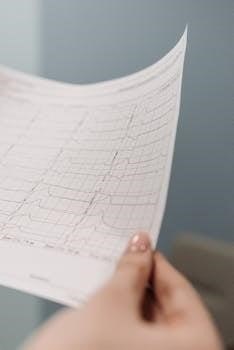What is the Functional Independence Measure (FIM)?
The Functional Independence Measure (FIM) is a widely used assessment tool that evaluates a patient’s functional status and independence levels. It measures the amount of assistance required for daily activities. This comprehensive overview explains what FIM scoring entails and its importance in healthcare settings.
Definition and Purpose of FIM
The Functional Independence Measure (FIM) is a standardized assessment instrument designed to evaluate the functional status of individuals undergoing rehabilitation. It focuses on assessing the level of assistance required for a person to perform basic life activities safely and effectively. The FIM’s primary purpose is to track a patient’s progress over time, identify areas where additional intervention may be needed, and to provide a consistent measure for comparing outcomes across different settings. It is used to monitor changes in functional independence during rehabilitation.

FIM Scoring System
The FIM uses a standardized scoring system to measure functional independence. This system employs a 7-point ordinal scale, with scores ranging from total assistance to complete independence, reflecting the level of support needed.
7-Point Ordinal Scale
The FIM employs a 7-point ordinal scale, where each point represents a different level of assistance required for a specific task. A score of 1 indicates total assistance, meaning the individual requires complete help. Conversely, a score of 7 signifies complete independence, indicating the person can perform the activity safely and timely without any help. The scores in between reflect varying degrees of assistance, from modified independence to minimal or moderate help. This scale considers the use of adaptive equipment and supervision.
Scoring Range and Interpretation
The FIM scoring range spans from 18 to 126; A lower total score, closer to 18, indicates a higher level of dependence, suggesting the patient requires significant assistance across various activities. Conversely, a higher score approaching 126 signifies greater independence. This means the person can perform most tasks with minimal or no help. The scores are generally recorded at both admission and discharge, to track progress and measure the effectiveness of the rehabilitation.
Areas Assessed by FIM
The FIM assesses both motor and cognitive functions. Motor items include areas like eating, grooming, and transfers. Cognitive items focus on comprehension, expression, social interaction, problem-solving, and memory.
Motor Function Items
The motor function items of the FIM encompass a range of activities related to physical mobility and self-care. These items include eating, grooming, bathing, upper and lower body dressing, toileting, bladder management, and bowel management. Additionally, it assesses bed to chair, toilet, and shower transfers, locomotion, and stair climbing. These items measure a person’s ability to perform these essential tasks safely and effectively, reflecting their physical independence.
Cognitive Function Items
The cognitive function items of the FIM evaluate a person’s mental abilities necessary for daily living. These areas include comprehension, expression, social interaction, problem-solving, and memory. These items assess a person’s ability to understand and communicate, interact appropriately with others, make decisions, and recall information, all of which are crucial for functional independence. These cognitive aspects complement the motor function assessment in the FIM.

FIM Assessment Process
The FIM assessment process involves evaluating a patient’s functional abilities through direct observation. It is typically conducted at admission and discharge to track progress. Standardized scoring ensures reliable measurement of independence levels.
When FIM Assessments are Conducted
FIM assessments are typically conducted at the start of a patient’s rehabilitation program, often upon admission to an inpatient facility. These initial assessments serve as a baseline to gauge the patient’s functional abilities. Subsequent assessments are performed at discharge, providing a clear measure of progress made during the rehabilitation process. Sometimes interim assessments are also used to monitor progress and adjust treatment plans as needed. Follow up assessments also can be conducted. These assessments are vital for tracking changes in functional independence.
Time Required for FIM Assessment and Training
Training individuals to reliably use the FIM scale requires approximately one hour of dedicated instruction. This training ensures consistent application of the scoring system. Once trained, administering the FIM assessment for each patient takes around 30 minutes to complete. This includes observing the patient’s performance and assigning appropriate scores based on the level of assistance required. The efficiency of the assessment process is crucial for practical implementation in busy clinical settings.
Use of FIM in Various Settings
The FIM is utilized in inpatient rehabilitation, community settings, and even in-home care. Its adaptability makes it suitable for tracking functional status across diverse healthcare environments.
Inpatient Rehabilitation
In inpatient rehabilitation facilities, the Functional Independence Measure (FIM) is a cornerstone for assessing patients’ functional abilities upon admission and at discharge. FIM scores help track progress during the rehabilitation process, providing valuable data for treatment planning and measuring the effectiveness of interventions. It serves as a standardized tool to evaluate independence in performing daily tasks, guiding care and discharge planning. The FIM assessment is crucial for monitoring a patient’s rehabilitation journey.
Community and Home Settings
Beyond inpatient settings, the Functional Independence Measure (FIM) is increasingly used in community and home environments. It serves as a basic indicator of Activities of Daily Living (ADL) for eligibility and funding schemes. The FIM helps assess an individual’s ability to function independently at home. This information is essential for determining the need for support services. Its use in these settings highlights its versatility in diverse care environments. The FIM also assists in Rehab in The Home (RITH) for substitute inpatient care.
Psychometric Properties of FIM
The FIM demonstrates good reliability and validity, crucial for accurate assessment. Studies show fair-to-good agreement across motor items, supporting its use as a reliable measure of functional independence.
Reliability and Validity
The Functional Independence Measure (FIM) has demonstrated acceptable psychometric properties, essential for a standardized assessment tool. Studies reveal fair-to-good inter-rater reliability across most motor items, indicating consistency in scoring by different assessors. However, some motor items, such as eating, grooming, bathing, and dressing of the lower body, showed lower agreement. The FIM’s validity is supported by its sensitivity to changes in functional independence over time, making it useful in tracking patient progress during rehabilitation.

FIM as a Predictor
The Functional Independence Measure (FIM) serves as a valuable predictor in rehabilitation. Specifically, admission motor FIM scores are a strong predictor of length of stay and discharge motor function.
Predicting Length of Stay
The Functional Independence Measure (FIM), particularly the motor subscale scores obtained at admission, has shown to be a significant predictor of a patient’s length of stay in rehabilitation settings. Research indicates that admission motor FIM scores account for a notable portion of the variance in the duration of a patient’s inpatient rehabilitation stay. This predictive capability is valuable for resource allocation and discharge planning. Also, it helps healthcare professionals anticipate patient needs and optimize their rehabilitation journey, improving efficiency in the process.
Predicting Discharge Function
The Functional Independence Measure (FIM) is not only useful for predicting length of stay but also for forecasting a patient’s functional abilities at the time of discharge. Studies have demonstrated that a patient’s admission FIM scores, both motor and cognitive, are strong indicators of their functional status upon discharge from rehabilitation programs. Specifically, admission motor FIM scores are a good predictor of discharge motor function, and admission cognitive FIM scores are good predictors of discharge cognitive function. These findings help in setting realistic goals for rehabilitation outcomes.
Alternative Assessment Tools
While FIM is widely used, the need for alternative assessment tools arises when FIM assessments cannot be conducted. This highlights the importance of having other options to evaluate a patient’s functional status.
Need for Alternatives
The absence of FIM assessments for some patients underscores the necessity for alternative evaluation tools. Certain situations may prevent FIM’s application, necessitating other methods to determine functional abilities. These alternatives are crucial for ensuring all patients receive comprehensive evaluations, regardless of their specific circumstances. The availability of diverse assessment tools provides a broader perspective on patient’s functional status. This variety is essential in settings where FIM may not be feasible.

Resources and Training for FIM
Training materials and guidelines are available to ensure proper FIM administration. It takes one hour to train a rater on the FIM scale, facilitating consistent and accurate assessments by practitioners.
Training Materials and Guidelines
Comprehensive training materials are essential for accurate FIM administration. These resources include detailed guidelines on scoring each of the 18 items. Proper training ensures consistent application of the 7-point ordinal scale, which ranges from total assistance to complete independence. Training typically requires about one hour for raters, and scoring each patient takes approximately 30 minutes. Standardized training helps maintain the reliability of FIM assessments across different settings and providers.
